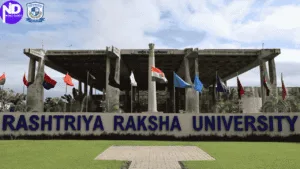RRU And Tata Build Digital Security Fabric For India
Newz Daddy Educational Updates
Rashtriya Raksha University and Tata Communications sign MoU to jointly work on India’s next-gen Digital Security Fabric for Law Enforcement & Defence Rashtriya Raksha University (RRU), an Institution of National Importance under the Ministry of Home Affairs, has signed a Memorandum of Understanding (MoU) with Tata Communications to accelerate research, pilots, and capacity building on next-generation and standards-driven secure communications for Law Enforcement Agencies (LEAs) and Armed Forces.

This partnership is a strong step toward modernising India’s security communication systems. RRU, known for its academic excellence in security and policing, has been collaborating with national agencies to bring advanced technology into real-life use. Tata Communications, one of India’s top global digital ecosystem enablers, has deep expertise in secure networking and communication. By working together, both institutions aim to create solutions that meet the complex needs of India’s security forces in both urban and remote regions.
Guided by the Hon’ble Prime Minister’s vision of a digitally sustainable India and the goal of contributing to the $1-trillion digital economy, the collaboration establishes a joint RRU–Tata Communications Secure Communications Testbed to prototype, evaluate, and operationalise mission-grade networking across contested, bandwidth-constrained, and intermittently connected environments.
India’s vision for a digital economy depends on secure networks that work reliably, even in tough conditions. Law enforcement and defence personnel often work in remote or hostile areas where the internet and mobile networks may not function properly. This new testbed will allow them to test and build communication systems that can withstand interruptions, cyberattacks, and challenging terrains. This is especially important for border areas, disaster zones, or military operations.
Next Generation data-centric design enables in-network caching and name-based retrieval, keeping critical messages, maps, and sensor feeds available even with intermittent connectivity, jamming, or infrastructure outages. This means even if networks are weak or under attack, the data needed by officers, like live maps or drone feeds, will still be accessible. This kind of resilience is essential for emergency response and security operations, where every second matters.
Every data object can be cryptographically signed and verified. In today’s digital world, securing data at its source is more reliable than securing only the network. Cryptographic signing ensures that the information is authentic and has not been tampered with, which is vital for operations involving sensitive or classified data.
The stack is designed to ride over 5G/6G, satellite/NTN, tactical radios, and edge mesh, reducing dependence on a single transport and enabling rapid field deployment. This allows officers to switch between different communication systems without losing connectivity. If 5G fails, satellite or tactical radios can take over. This flexibility is essential in areas with limited infrastructure.
Identity, access, and integrity are bound to the data itself, enabling secure cross-agency sharing while enforcing least-privilege access and auditability. Zero-trust architecture is becoming the gold standard worldwide. It treats every user and device as untrusted until verified. For law enforcement and defence, this approach prevents unauthorised access and makes communication between agencies more secure.
A reference architecture and implementation playbooks will shorten pilot-to-production timelines for city police, CAPFs, and defence formations. This means new technologies can move from testing to real use much faster. Instead of waiting months or years, police and armed forces can deploy secure communication systems quickly during emergencies.
Work will align with Internet Engineering Task Force (IETF)/Internet Research Task Force (IRTF) information-centric networking efforts and Indian standards bodies, supporting Make-in-India integration and long-term sustainability. Aligning with international and national standards ensures that the solutions are future-proof and compatible with global practices, while keeping the core technology sovereign and locally developed. Campus and federated nodes for realistic mission scenarios, including lab-to-field telemetry and red-team validation. Realistic simulations help security agencies test how the system works during real-world challenges such as cyberattacks or natural disasters.
Reference designs integrating network, identity, cryptography, and observability with hooks for SOC/XDR and incident response. This blueprint will act like a master plan for secure communication, guiding future deployments for agencies across India. Controlled trials for secure messaging, body-cam offload, IoT telemetry, digital-evidence transfer, and command-post networking. This step ensures that the technologies are field-tested in real operational environments like city policing, border posts, or disaster zones.
Joint training, certifications, and exercises for officers and engineers; courseware and labs to create a skilled national cadre. India faces a shortage of cybersecurity experts in law enforcement. Training programs through this MoU will help create a strong pool of skilled officers and engineers who can handle advanced communication systems. “This partnership exemplifies RRU’s mission to translate research into real-world security outcomes,” said Dr Bimal N Patel, Vice-Chancellor, RRU. “By combining Tata Communications’ carrier-class capabilities with RRU’s applied research and training ecosystem, we will help India’s LEAs and Forces communicate securely and reliably, anywhere.” Dr Patel’s leadership has turned RRU into a hub for innovation in security education, often bridging the gap between academic research and field use.
Dr Tushar Sood, Senior Executive at Tata Communications, said, “NDNIP-less architectures are a cornerstone of our next five-year technology strategy. Together with RRU, we aim to deliver field-tested, standards-aligned solutions that enhance operational resilience for India’s security agencies.” Tata Communications’ involvement brings the scale and expertise needed to roll out these solutions across India. Mr Harish Chowdhary, CISO & Head–ICT & Strategic Projects at RRU, added, “Our joint testbed will let agencies evaluate mission use-cases end-to-end planning, deployment, forensics, and after-action review, so adoption is faster, safer, and measurable.”
This approach ensures the technology is not only built but also monitored and improved continuously.